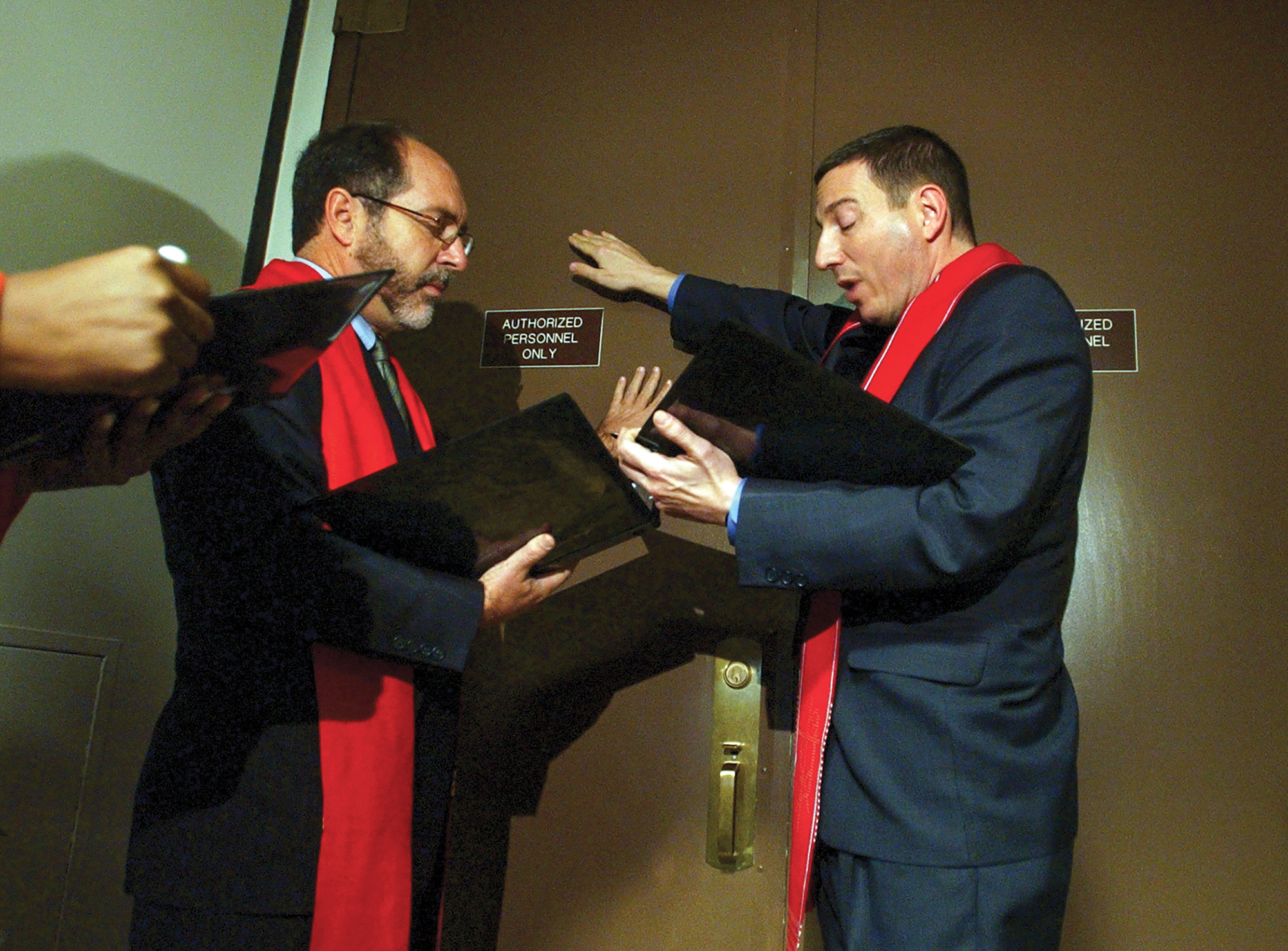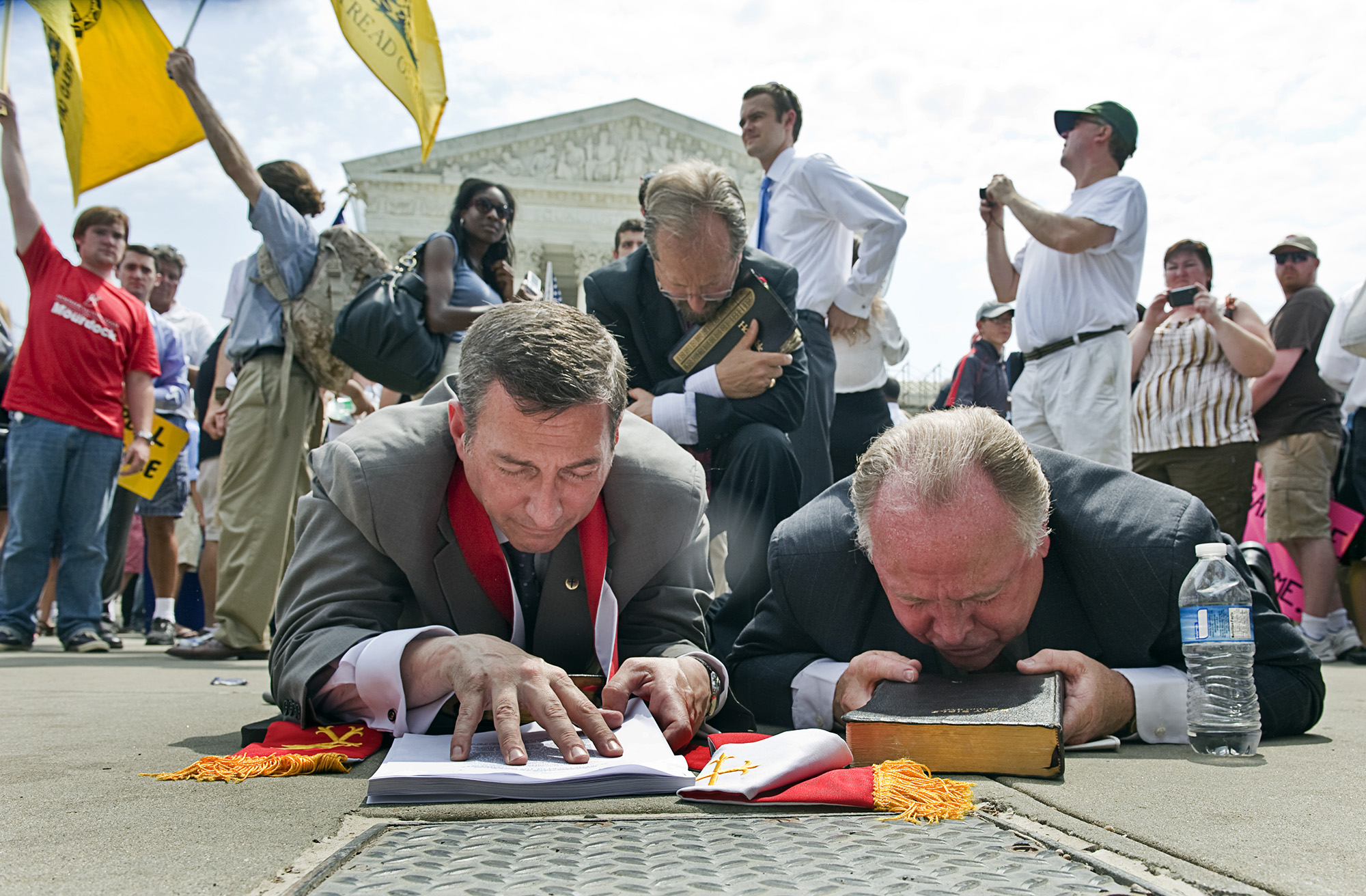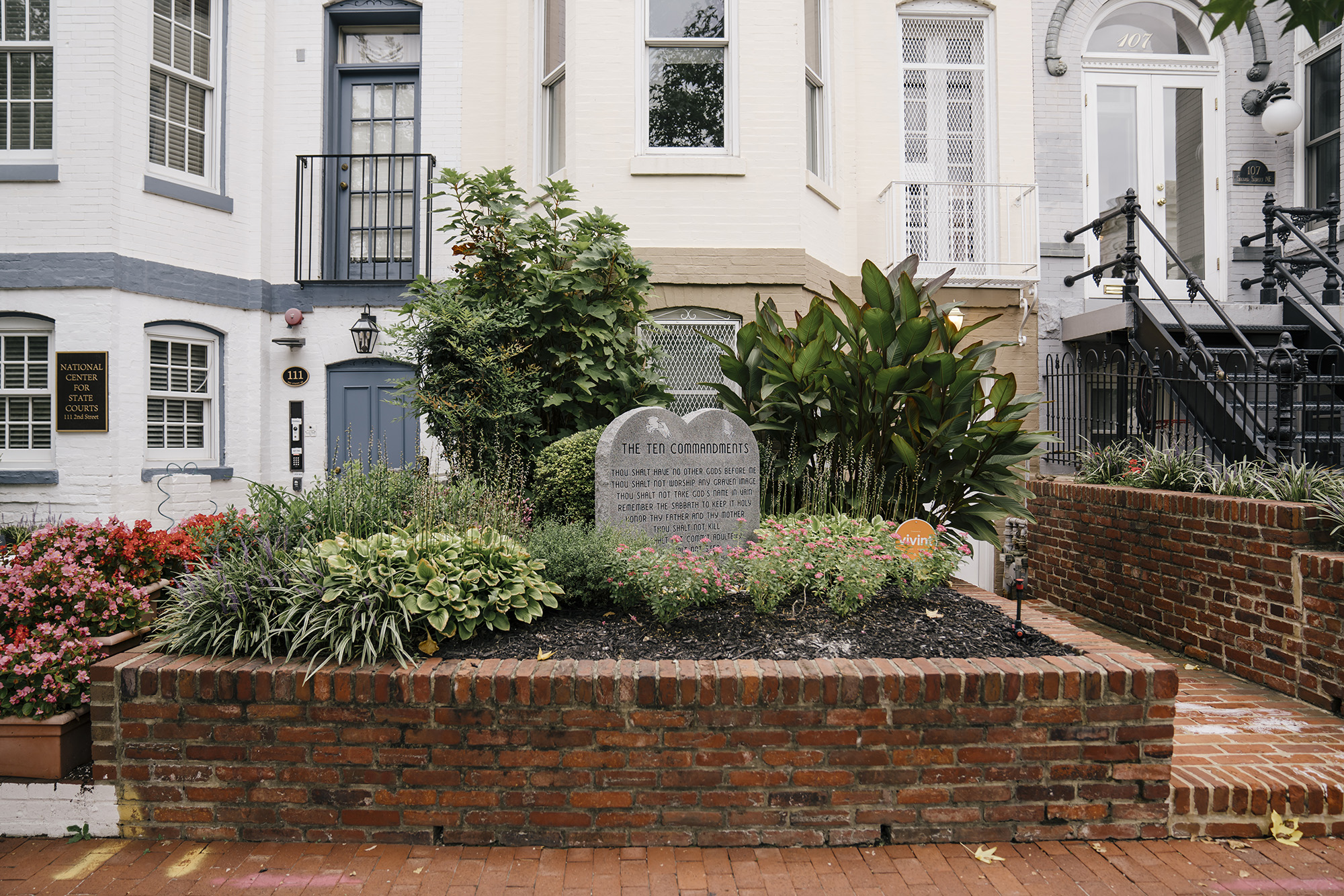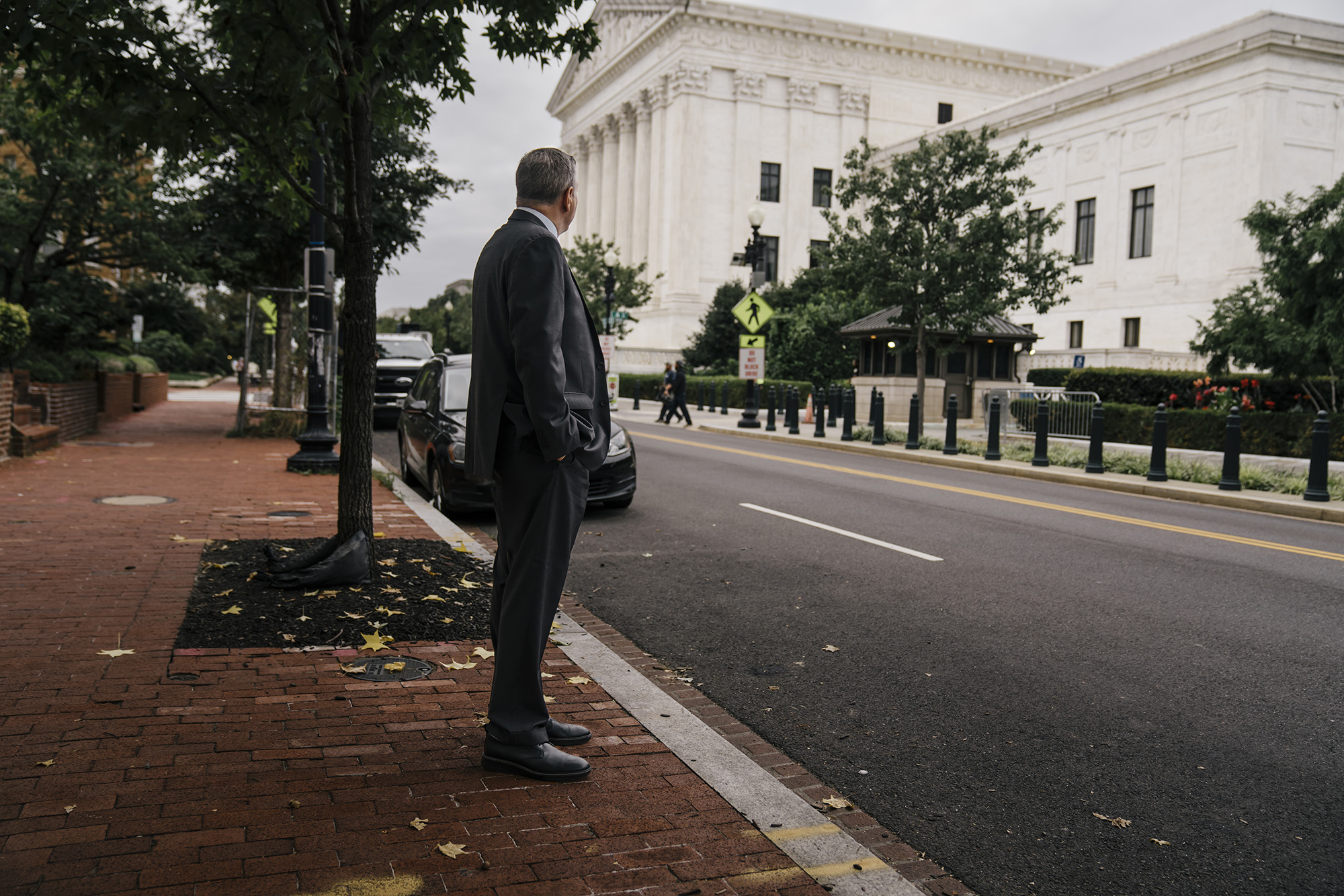
Our November+December issue investigates the Christian nationalist movement that aspires to take over government at all levels, from school boards and state legislatures to Congress and the Supreme Court. Read the series of stories here.
In 2014, at an elegant gala inside the Supreme Court’s gilded Great Hall, a tuxedoed Justice Clarence Thomas turned to me and voiced his approval for my work. I glanced over to where Chief Justice John Roberts and his wife, Jane, were entertaining two of my associates, trustees of the Supreme Court Historical Society, a private, nongovernmental entity for which Roberts served as honorary chair. At that moment, I knew the secretive operation I had run, aimed at emboldening Thomas and his conservative colleagues to render the strongest possible decisions in favor of our right-wing Christian agenda, had succeeded.
My organization, Faith and Action in the Nation’s Capital, had created an initiative we called “Operation Higher Court” that trained wealthy couples as “stealth missionaries,” befriending Thomas and his wife, Ginni; Samuel and Martha-Ann Alito; and Antonin and Maureen Scalia—lavishing them with meals at high-end restaurants and invitations to luxurious vacation properties. Alongside these amenities, our ministry offered prayers, gift Bibles, and the assurance that millions of believers thanked God for the decisions this trio of justices rendered on abortion, health care, marriage, and gun ownership.
The Supreme Court was the pinnacle of my success, but I had started with Congress, advanced to the White House, and only then took on the judicial branch. Under the banner of Faith and Action, our mission, in evangelical parlance, was “to bring the Word of God to bear on the hearts and minds of those who make public policy in America.” Backing me were some 50,000 donors, spread across the country, along with hundreds of church leaders and several prominent lawmakers. The goal was to convert a “secular culture” into a God-fearing, foundationally Christian, socially conservative, and politically Republican one. To achieve it, we raised tens of millions of dollars, mobilized activists, and lobbied lawmakers relentlessly. We accomplished all of this from the headquarters I procured in Washington, just across the street from the Supreme Court.
In effect, we were like other lobbyists and pressure groups, only our visits to offices included saying a prayer or reading a Bible verse with the occupant. Clergy, often arrayed around the stately benches where members of both houses of Congress sit during official proceedings, accompanied us to more formal meetings. Our large public events, like the annual National Memorial for the Pre-Born and Their Mothers and Fathers or the US Capitol Bible Reading Marathon, would turn government venues into temporary church sanctuaries. “Christian nationalist” was yet to become a common expression, but my allies and I were that in every way. We believed America was founded as a Christian nation and needed to be preserved as such.
Besides establishing a national organization aimed at making America part of a revivified Christendom, I chaired the National Pro-Life Religious Council, which dedicated itself to ending Roe. After Norma McCorvey recanted her pro-abortion stance as Jane Roe, Faith and Action supported her financially. I consulted for the American Center for Law and Justice, an ultraconservative legal advocacy organization; campaigned for George W. Bush, Mitt Romney, and John McCain; and helped Roy Moore, then Alabama’s chief justice, physically install a Ten Commandments monument in the state Supreme Court building.
When President George W. Bush nominated Roberts for chief justice, I was in a private box seat at the Senate confirmation hearing. At Alito’s confirmation, I was the guest of Sen. Orrin Hatch of Utah, the three-time Senate Judiciary Committee chair. And when Donald Trump chose Neil Gorsuch after Scalia’s death, not only was I present for the hearing, but a month before, I had coordinated prayers for Gorsuch and his family in a nearby chapel. On more than one occasion, I knelt in prayer alongside Mike Pence (when he was a member of Congress from Indiana) and other lawmakers in the vanguard of the new right.

My efforts were rewarded handsomely. I spoke at many of the largest churches in the country and at events that drew thousands of attendees. I grew accustomed to being picked up by executive limousines, flying in private jets, and eating in the finest restaurants.
We in the religious right helped foster a political culture that has produced the likes of Rep. Marjorie Taylor Greene (R-Ga.), Sen. Josh Hawley (R-Mo.), and former President Trump. It also gave rise to the Mississippi Republican legislators who challenged Roe v. Wade, handing Justice Alito the opportunity to write the opinion that destroyed it. My task was to convince religious leaders, officials on every level of government, and big-money benefactors that our nation was literally going to hell and the only way to rescue it was a mass conversion to Christian sensibilities. Preachers and politicians might be able to persuade some people, but the force of law would be necessary to coerce others.
Much to my present regret, we succeeded.
My three siblings and I were raised to respect people of all religions—and none. In my late teens, I searched for a faith and found it in a little country church where I accepted Jesus Christ as my Lord and Savior. Almost immediately, I felt called to give my life to Christian service. A few years later, in the late 1970s as a young minister in Rochester, New York, I received a disturbing call from a woman demanding to know my position on abortion. I hadn’t given it much thought, I said, and she excoriated me. Unsettled, I looked for information on the Christian view of abortion. I found a 1978 sermon titled “Abortion-on-Demand: Is It Murder?” by the Reverend Jerry Falwell Sr., a celebrated Southern Baptist preacher and host of the popular Old Time Gospel Hour. He called for ending legal abortion. “Christians ought to join forces together on this one issue and, whatever it takes, put it through,” he said. “[T]he question of abortion on demand threatens our nation.”
America could either choose God’s way and enjoy prosperity or take the devil’s path to destruction. God’s way meant wives were to dutifully submit to their husbands “as unto the Lord”; children were to obey their parents; and everyone was to attend church, Sunday school, and Bible study. Prayer and Bible reading needed to be returned to public school classrooms. Children should be taught that sex is strictly for married couples; young people must remain virgins until their wedding night; and intercourse, while enjoyable, was principally for procreation.
Falwell’s gospel differed distinctly from the one I had initially responded to, the one with a compassionate Jesus who blessed the poor, the forgotten, and the persecuted. Falwell’s message, while sprinkled with side references to marginalized people, implied they may have caused their own problems. Instead of calling upon believers to be peacemakers and to love one another, as Jesus did, Falwell’s Christians were modern-day crusaders conquering an evil, secular world. I embraced his challenge, feeling I could remedy the ills that beset our country, from drug use to premarital sex.
By 1983, I was fully engaged with our new national evangelical political influence and had a front-row seat at the annual convention of the National Association of Evangelicals, where, for the first time, a sitting president addressed this body of leaders. In that now-famous “Evil Empire” speech, named for his reference to the former Soviet Union, President Ronald Reagan ticked off everything I had come to see as threats: secularism, promiscuity, and government interference with churches while barring school prayer and restricting students’ religious speech. “Abortion on demand now takes the lives of up to one and a half million unborn children a year,” Reagan continued. “Human life legislation ending this tragedy will someday pass the Congress, and you and I must never rest until it does.” He framed a perfect argument for this audience, saying, “There is sin and evil in this world, and we’re enjoined by Scripture and the Lord Jesus to oppose it with all our might.”
He framed a perfect argument for this audience, saying, “There is sin and evil in this world, and we’re enjoined by Scripture and the Lord Jesus to oppose it with all our might.”
I was all in.
Thus inspired, I was primed for my second conversion. Pat Robertson—a popular Christian television personality, media mogul, and, for many of us, divinely anointed prophet—was my guide. Robertson’s vision for the country was the first to dominate electronic media, starting with the Christian Broadcasting Network, the international television enterprise he’d founded in the early 1960s. In 1977, adding education to his list of divine objectives, he founded Regent University. With the American Center for Law and Justice in 1990, he created an organization to counter what he perceived to be the excessively liberal ACLU. The enemies of America were secular humanists, he argued; to defeat them, we needed to restore “Judeo-Christian traditions.” With our favorite president and most revered prophet urging us to fight for the soul of our nation, fight we would. Naturally, we got behind Robertson’s 1988 presidential campaign.
In 1987, my twin brother, Paul, the pastor of a large church in suburban Buffalo, New York, held a funeral for fetal remains that one of his parishioners found in a waste container outside a local medical building. He convinced me to join him and others in blockading the facility’s doors. This is how I became part of what we referred to then as the Rescue movement, a loose network of activists determined to shut down reproductive health care services. At first, our actions mimicked nonviolent tactics—like the sit-ins of the civil rights era—but the tone changed markedly during the Clinton years, when movement leaders became more aggressive. Physical confrontations between pro-choice and anti-abortion protesters became more common. Then, the shootings began—three deadly incidents targeting abortion providers within two years. Even as I publicly expressed concern and shock over the violence—while emphatically distancing our movement from any responsibility—I realized we had unleashed forces we might never be able to control.
In my corner of the movement, male leaders began sporting broad-brimmed cowboy hats, oversized belt buckles, Western boots, and sometimes empty holsters, indicating that they had ready access to firearms. The once laser-focused anti-abortion message was replaced by a mishmash of screeds asserting strictly binary gender roles, opposition to LGBTQ rights, and denunciation of “feminazis” and “Jezebels”—like Hillary Clinton.
Though I was uncomfortable with some of the more extreme methods and rhetoric, I remained committed to what I saw as an effort to reclaim morality. I also felt called to expand my ministry to all three branches of government, so in 1994, I relocated to Washington. First, I distributed plaques of the Ten Commandments to Republican members of Congress, encouraging them to unapologetically champion a Judeo-Christian agenda. I also invited a controversial Alabama judge to DC, where I staged a national news conference for him in the Capitol.
Roy Moore had defied a federal court order to remove his hand-carved replica of the Ten Commandments from his courtroom. I recruited co-sponsors for a congressional resolution co-authored by then–Alabama Sen. Jeff Sessions that passed the House but stalled in the Senate. It stated, “The public display, including display in government offices and courthouses, of the Ten Commandments should be permitted.” When Moore was elected chief justice, I helped him set in place a large granite Ten Commandments monument inside the Alabama Judicial Building. He later refused to move it, in direct defiance of a federal court order. (Later, as a Senate candidate, Moore would be accused by multiple women of sexual assault and misconduct, allegations he denied.)
When religion is placed at the service of a political party, it corrupts both. To claim that one political figure uniquely represents God’s will is a form of anti-Christian idolatry.
In Washington, I also occasionally administered Holy Communion and delivered sermons in the Congressional Prayer Room, offered invocational prayers at functions in the Capitol complex, and linked arms with groups like the Family Research Council, the Heritage Foundation, and the formidable Council for National Policy. The CNP—a nearly clandestine cabal of conservative religious, business, and political movers and shakers—assembled some of the country’s wealthiest and most powerful figures in closed-door sessions, where we heard from insiders like Supreme Court spouse Ginni Thomas and Richard Viguerie, the doyen of conservative fundraising. He held forth during cocktail hours, regaling listeners with stories of how the Red-baiting 1950s Wisconsin Sen. Joseph McCarthy inspired him to battle the communists bent on taking over America.
By the winter of 2001, many other religiously motivated public interest groups were working the executive and legislative branches, so I decided to concentrate on the judiciary. In confidential meetings of top anti-abortion activists known as the 115 Forum (named for a hotel meeting space), we discussed how the federal judiciary, especially the Supreme Court, was the obstacle to any progress we had made in the other two branches. Something had to be done about what some derisively called “Article Threes,” the judges and courts authorized under that section of the Constitution. Supporting federal and state legislative efforts could only take us so far. We needed to get to these jurists personally.
First, I befriended a couple of lower-level federal judges. Sen. Hatch introduced me to others. But a culmination of my efforts was an invitation to members of the prestigious Judicial Breakfast Group from “The Chambers of Justice Clarence Thomas” announcing me as the speaker. The subject would be the Ten Commandments. I concluded my talk by asking the 50 or so judges in the room to proudly incorporate their Christian beliefs into their jurisprudence.

Federal judges and especially Supreme Court justices, unlike politicians, never need to shake hands across a rope line. Accessing their world required creativity. I found it through the little-known Supreme Court Historical Society. Founded by the late Chief Justice Warren Burger, the independent nonprofit holds an annual dinner hosted by the chief justice and attended by most associate justices. Tickets are strictly controlled. By establishing a close relationship with the society’s staff, I managed to secure seats each year for several of my donors, whom I would coach on how to connect with the justices attending the event. As a result, two of my most active participants, Don and Gayle Wright of Dayton, Ohio, ingratiated themselves with the Alitos, Scalias, and Thomases.
When I trained my donors to interact with conservative justices on the court, I told them to reinforce for their powerful new friends how important their decisions were to the country’s future, and how critical Judeo-Christian values are to America’s success. I encouraged them to underscore how millions of citizens thanked God for their presence on the top court.
In a notable instance, the Wrights were tipped off about a pending decision before it was announced to the public. As I later told the House Judiciary Committee, “Gayle relayed that she had learned the outcome of the Burwell v. Hobby Lobby case while at the meal with the Alitos, that it was in Hobby Lobby’s favor, and that ‘Sam is writing it.’” The ruling would affirm that companies with religious objections were not required to provide contraceptive coverage in their health insurance packages. I also told the House committee that Gayle had shared the news with me and that I told the president of Hobby Lobby, Steve Green—his parents were donors to my organization—that they had won the case. The Green family found themselves in the enviable position of using the advance notice to prep their spokespeople so they could be ready at the microphone outside the court following Alito’s reading of the majority opinion. They could shape the public narrative, a distinct advantage over their opponents.
When word of our campaign eventually broke in the New York Times, Justice Alito responded, “I never detected any effort on the part of the Wrights to obtain confidential information or to influence anything that I did in either an official or private capacity, and I would have strongly objected if they had done so.” He added, “I have no knowledge of any project that they allegedly undertook for ‘Faith and Action.’” Gayle Wright denied obtaining or passing along any such information. Steve Green declined to comment to the Times, and his mother told the paper he hadn’t been notified in advance. Let’s just say this is not how I remember what had happened.

It took years for the scales to fall from my eyes. A major turning point occurred when I took a leave of absence from Faith and Action to pursue a late-in-life doctorate. Part of my research involved the German Christian movement of the 1930s, which supported the Nazi Party. One of the most respected Bible scholars of that period, Paul Althaus, declared Hitler’s ascent to the chancellorship to be a “gift and miracle from God.” I began to suspect that we evangelicals were similarly allowing our faith to be co-opted for political purposes. Devastating consequences seemed inevitable for evangelicalism and for our country.
These fears were reinforced when I attended a tribute banquet for Pat Robertson around 2010. Virtually every evangelical luminary was there. When Robertson introduced his guest of honor, Donald J. Trump, I was shocked. In Bible college, my preaching instructor had suggested that the New York playboy was a perfect illustration for what it meant to not live as a Christian. I asked a friend of Pat’s why Trump was there. They both were “members of the billionaires’ club,” he explained. “Besides, he may make a good president someday.” Trump worked the room, filled with the biggest names on the religious right, garnering hearty applause.
When Robertson introduced his guest of honor, Donald J. Trump, I was shocked. In Bible college, my preaching instructor had suggested that the New York playboy was a perfect illustration for what it meant to not live as a Christian.
Another reckoning came after working with Abigail Disney on a film about American evangelicals’ love affair with firearms. The Armor of Light won an Emmy, but many of my colleagues labeled me a sellout to liberal gun grabbers. Pastors told me my appearance in the film created tensions in their congregations. When I visited one church as a guest preacher, my host forbade me from mentioning guns in his pulpit. “I have 50 armed people sitting out there every Sunday,” he warned, “and I don’t know what they’ll do if they get mad at you.” He gave me a wry smile. “Seriously.”
Meanwhile, as a Republican presidential candidate, Trump displayed pomposity and an ugly denunciation of the most vulnerable, both of which are diametrically opposed to the Christian virtues of humility, kindness, love for neighbors, and care for strangers. In June 2016, when his campaign invited scores of my closest friends and longtime colleagues to meet with him in New York, I declined. My contacts texted me from the gathering, reporting on the deal they were striking with him. Trump essentially promised to appoint anti-abortion federal judges and Supreme Court justices in exchange for our constituents’ loyal support. James Dobson, founder of the enormously influential Focus on the Family, assured attendees that Trump was a “baby Christian.”
When I arrived at the Republican National Convention in Cleveland, Trump’s nomination was a fait accompli. Sitting at a luncheon table with evangelical leaders, I expressed bewilderment over our support of him. Repeatedly, I was assured he would advance our cause. After Trump’s acceptance speech, I decided to leave the fold.
It took two years to extract myself. I dismantled the organization I had spent more than two decades building, walking away from a multimillion-dollar donor base. I called countless people to explain why I was leaving the movement I’d helped lead. I reached out to others to beg their pardon for the harm I had inflicted. I repented in prayer for my errors and the damage they caused. Then, I privately dedicated the rest of my life to doing as much repair as possible.

Following the insurrection of January 6, when Christian banners, Bibles, and prayers in Jesus’ name appeared in the assault on the Capitol, I felt even greater urgency in warning my fellow evangelicals of the grave danger Trump and his MAGA cult posed to Christianity and US democracy.
My change of course so late in life has been painful, disorienting, and costly. Besides losing decades-long friendships and enduring menacing threats, my wife and I have faced a significantly reduced income. I’ve even driven Uber to cover household expenses. One night, I picked up an organizer of the National Prayer Breakfast, an event in which I had once played a significant role. I was wearing a mask and said little, but then, with trepidation, I realized I would be dropping him at the home of a congressman I had worked with closely for more than 20 years. When my passenger got out, I was relieved to have gone unrecognized. Still, I’ve never questioned the decisions that brought me to that moment.
In my third conversion, I realized that when religion is placed at the service of a political party, it corrupts both. To claim that one political figure uniquely represents God’s will for the body politic is a form of anti-Christian idolatry. To elevate one set of spiritual beliefs above another and do it by force of law removes a nonnegotiable tenet of evangelical faith—free will. We are born again when we choose to believe in the Lord Jesus Christ, not when we’re forced to do so.
Because it is immoral, I believe Christian nationalism is inevitably doomed. But in the meantime, the pain, suffering, and injury it will inflict will be enormous—just consider women facing difficult pregnancies, trans children seeking care, librarians attacked for certain books. “We want to fill our culture again with the Christian spirit. We want to burn out all the recent immoral developments in literature, in the theater, and in the press—in short, we want to burn out the poison of immorality, which has entered into our whole life and culture as a result of liberal excess.” This may sound familiar—maybe some overheated Republican talking points. In fact, it’s what Adolf Hitler promised the German people in 1933.
Read our full investigation into the rise of Christian nationalism.















